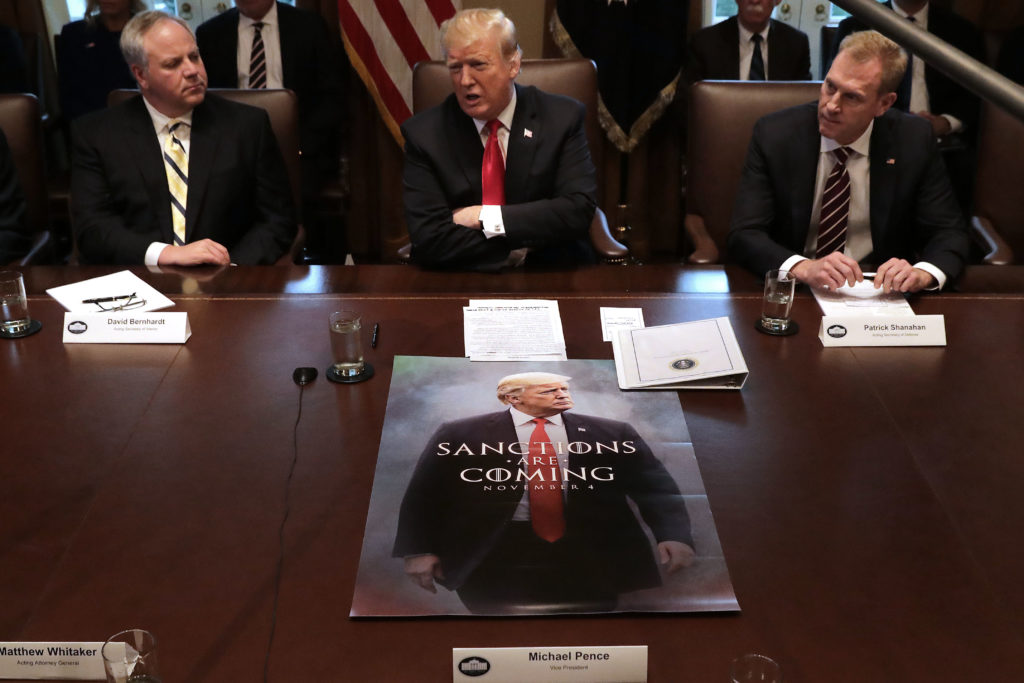US pesident Donald Trump (C) leads a meeting of his Cabinet, including then-Interior Secretary David Bernhardt (L. (Chip Somodevilla/Getty Images)
The US Department of the Interior is designed to tirelessly protect the nation’s natural heritage and culture, but sexual orientation is no longer protected by the agency’s workplace discrimination guidelines.
The department removed language regarding LGBT+ people from its anti-discrimination guidelines, HuffPost reported, becoming the latest salvos from the Trump administration against queer people.
“You shall adhere to all laws and regulations that provide equal opportunities for all Americans regardless of race, colour, religion, sex, age or handicap,” reads one of 14 principles of ethical behaviour in the agency’s 2017 guidelines.
Gender identity and sexual orientation are both notably absent from the department booklet, which gives the blueprints for handling workplace discrimination.
‘Sexual orientation’ crossed out and cut from anti-discrimination guidelines in US department.
It’s in stark contrast to the 2009 edition of the guidelines – under the Obama administration – which covered the categories of “race, colour, religion, gender, sexual orientation, age or disability”.
Moreover, on his first day on the job, then-Deputy Interior Secretary David Bernhardt sent department staff a copy of the guidelines where “sexual orientation” was missing.
But internal documents obtained by environmental non-profit Friends of the Earth in November through a freedom of information request showed the guidelines bleeding red.
In the copy, “sexual orientation” is crossed out in red ink as well as several other minor alterations.
However, it remains unclear who made the edits.
An Interior spokesperson chalked up the removal to simplifying terms.
Carol Danko told the paper that the agency guidelines comply with the Equal Employment Opportunity Commission’s interpretation of Title VII of the Civil Rights Act of 1964.
The measure prohibits discrimination on the basis of race, religion and sex, which extends to LGBT+ workers.
“Per the Equal Employment Opportunity Commission, under Title VII the term ‘sex’ includes gender, gender identity, transgender status, sexual orientation, and pregnancy,” Danko said in an email.
Interiors claim ‘sex’ protects LGBT+ people despite wider administration arguing against this.
But the Interiors’ logic contrasts with the wider administration’s actions.
Blockbuster cases are currently being handled by the Supreme Court, debating whether it’s legal to discriminate against LGBT+ folk in the US.
President Donald Trump has staked the judiciary with conservative judges, muddying the likelihood of a pro-LGBT ruling on the cases.

And in one case, his Department of Justice made the case that Title VII does not protect trans folk. Being that ‘sex’ only extends to one’s “biological” sex that is assigned-at-birth.
When reporters pressed the spokesperson on this, Danko did not respond. Instead, she accused HuffPost of chasing “a non-story seeking controversy where none exists.”
“Under Secretary Bernhardt’s leadership, the Interior Department has a zero tolerance policy for discrimination or harassment of any kind,” she added.
“In fact, our internal policies have been redrafted with a broader brushstroke to explicitly capture inappropriate conduct beyond the legal standards of harassment and discrimination such as political affiliation, sexual orientation, marital status, national origin, and status as a parent.”
‘Removing these protections sends a dangerous signal to workers’.
The redrafting of the guidelines was branded “dangerous” by Robin Maril, associate legal director at the LGBTQ advocacy nonprofit Human Rights Campaign.
“Departmental mission statements and guidance documents do set a tone for employees and for overall operations,” Maril said.
“Removing these protections sends a dangerous signal to workers and supervisors that non-discrimination protections are no longer a priority.”
